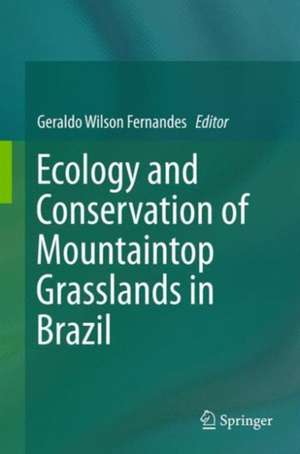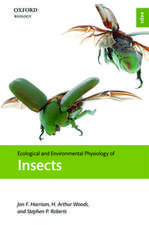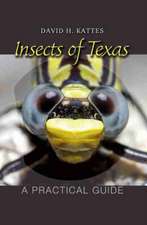Ecology and Conservation of Mountaintop grasslands in Brazil
Editat de Geraldo Wilson Fernandesen Limba Engleză Hardback – 4 mai 2016
| Toate formatele și edițiile | Preț | Express |
|---|---|---|
| Paperback (1) | 1058.69 lei 38-44 zile | |
| Springer International Publishing – 27 mai 2018 | 1058.69 lei 38-44 zile | |
| Hardback (1) | 1246.47 lei 3-5 săpt. | |
| Springer International Publishing – 4 mai 2016 | 1246.47 lei 3-5 săpt. |
Preț: 1246.47 lei
Preț vechi: 1520.07 lei
-18% Nou
Puncte Express: 1870
Preț estimativ în valută:
238.51€ • 249.73$ • 197.83£
238.51€ • 249.73$ • 197.83£
Carte disponibilă
Livrare economică 19 martie-02 aprilie
Preluare comenzi: 021 569.72.76
Specificații
ISBN-13: 9783319298078
ISBN-10: 3319298070
Pagini: 567
Ilustrații: XXIII, 567 p. 167 illus., 74 illus. in color.
Dimensiuni: 155 x 235 x 36 mm
Greutate: 1.27 kg
Ediția:1st ed. 2016
Editura: Springer International Publishing
Colecția Springer
Locul publicării:Cham, Switzerland
ISBN-10: 3319298070
Pagini: 567
Ilustrații: XXIII, 567 p. 167 illus., 74 illus. in color.
Dimensiuni: 155 x 235 x 36 mm
Greutate: 1.27 kg
Ediția:1st ed. 2016
Editura: Springer International Publishing
Colecția Springer
Locul publicării:Cham, Switzerland
Cuprins
1. TheMegadiverse Rupestrian Grassland.- 2. The Physical Environment of Rupestrian Grasslands (Campos Rupestres) inBrazil: Geological, geomorphological and pedological characteristics, andinterplays.- 3. Soils associated with rupestrian grasslands.- 4. Thermic andhydric dynamics of Ironstone (Canga) and Quartzite Rupestrian Grasslands in theQuadrilátero Ferrífero: the ecological importance of water.- 5. Water resources inthe rupestrian grasslands of the Espinhaço Mountains.- 6. Rupestrian grassland vegetation, diversity and origin.- 7. Archipelago of montane forests surrounded by rupestrian grasslands: newinsights and perspectives.- 8. Arbuscular mycorrhiza andendophytic fungi in ruspestrian grasslands .- 9. Successionon the rocky outcrop vegetation: a rupestrian grassland scheme.- 10. SeedGermination Ecology in Rupestrian Grasslands.- 11.Ecophysiology of campos rupestresplants.- 12. Phenologypatterns acrossa rupestrian grassland altitudinal gradient.- 13. Mutualisticinteractions among free-living species in Rupestrian Grasslands.- 14. Antagonisticinteractions in the rupestrian grasslands: new insights and perspective.- 15. Cerrado to Rupestrian grasslands:patterns of species distribution and the forces shaping them along analtitudinal gradient.- 16. Termite role in soil nutrient cycling in Ironstone Rupestrian Grasslands (canga)in Carajás, Brazilian Amazonia.- 17. Afforestationin the rupestrian grasslands: the augmenting presssure of Eucalyptus.- 18. Fire in RupestrianGrasslands: Plant Response and Management.- 19. Challenges in the restoration of quarzitic and ironstone rupestriangrasslands.- 20. The people of the mountains: thebiocultural heritage of Espinhaço Range in Minas Gerais State, Brazil.- 21. The Human Dimension in the EspinhaçoMountains: Land Conversion and Ecosystem Services.- 22.RupestrianGrassland: past, present and future distribution.- 23. The shady future of the Rupestrian Grassland: majorthreats to conservation and challenges in the Anthropocene
Notă biografică
Editor of the contributed volume:
Prof Geraldo Wilson Fernandes, Universidade Federal de Minas Gerais, Belo Horizonte, Brazil Textul de pe ultima copertă
This book is a pioneer attempt to bring forward the first synthesis on the most diverse and threatened mountain top vegetation of South America, the rupestrian grasslands. It brings to light the state of the art information on this ecosystem geology, soil formation and distribution, environmental filters that lead to biodiversity, species interactions and their fine tuned adaptations to survive the harsh mountain environment. The human dimensions of the rupestrian grassland are also addressed, including the anthropogenic threats that may irreversibly impact biodiversity and ecosystem services. The book also highlights the ongoing studies on ecological restoration and first attempt to model the impacts of climate change on its speciose biota.
Caracteristici
This is the sole scientifically based book on the rupestrian grassland ecosystem With over 150 color photos this book graphically transports you to the most diverse ecosystem of the tropics While the book presents a synthesis of knowledge of more than 120 yrs in the rupestrian grasslands, the impacts of climate and land use change is addressed in the Anthropocene Includes supplementary material: sn.pub/extras










